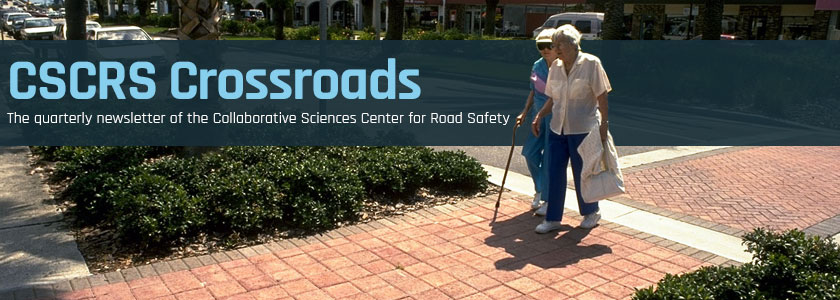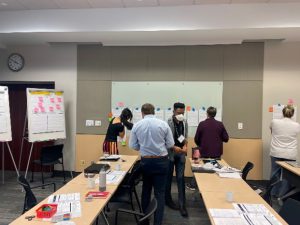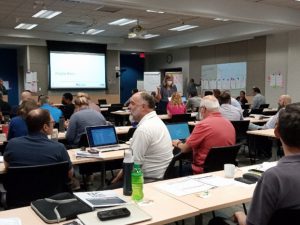Systems spotlight: New multimedia materials highlight six years of CSCRS Safe System work and accomplishments
CSCRS has reached its sixth-year anniversary as a U.S. Department of Transportation (USDOT)-funded University Transportation Center! To commemorate the occasion, we are excited to release new multimedia materials to tell the CSCRS story and highlight the breadth of our research and outreach activities that are helping shape a Safe System for U.S. roadways: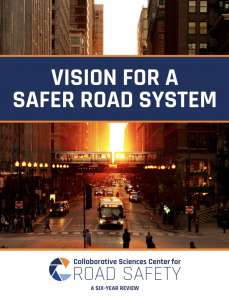
- The video “CSCRS Vision For A Safer Road System.”
- The report “Vision for a Safer Road System.”
- The two-page executive summary “Applying Fresh Approaches to Enduring Road Safety Problems.”
Thanks to USDOT, the CSCRS team, our Advisory Board, and our extended network of partners for a great six years of shared accomplishments! We look forward to continuing to work together to advance transportation safety through a multidisciplinary, systems-based approach.
September CSCRS online seminar to explore role of land development in street safety
The September 28, 2022, Research to Practice Bytes session is “Bringing development review into Safe Systems.” The presenters will be Tab Combs, Research Associate, Department of City and Regional Planning (DCRP), UNC Chapel Hill, and Jesse Saginor, Chair and Professor, Department of Urban & Regional Planning, Florida Atlantic University (FAU). They will examine the assumption that congestion mitigation “takes care of” road user safety, identify how to rethink land development’s impact on safety, and look at centering road user safety in development review.
Recordings and slide decks from previous webinars are available on the series website. The following session, “Case studies from across the US on using systems thinking tools to inform Safe System partnership, strategic planning, and research,” will be held on October 26, 2022. More details will be announced.
CSCRS researchers host second annual NC Vision Zero Leadership Team Institute
With support from CSCRS and the North Carolina Governor’s Highway Safety Program, the North Carolina Vision Zero Support Team (comprised of CSCRS researchers from UNC’s Injury Prevention Research Center [IPRC], Highway Safety Research Center [HSRC], and Gillings School of Global Public Health) hosted the second annual NC Vision Zero Leadership Team Institute in June 2022.
- NC Vision Zero Leadership Team Institute
- NC Vision Zero Leadership Team Institute
The Institute is a training resource for North Carolina communities with Vision Zero initiatives, or those who are considering the adoption of a Vision Zero initiative. The two-day institute provides multi-sector Vision Zero teams with best practice tools and approaches to help them move toward effective Vision Zero planning and implementation. This year’s institute included 10 teams from across the state with more than 13 different sectors represented across teams (e.g., advocates, emergency responders, engineers, planners, and local elected officials). Teams learned about different approaches to speed management and traffic calming, as well as tools for developing a diverse and sustainable coalition.
Focus on CSCRS education and professional development
CSCRS continues to provide and participate in a variety of learning activities including:
- Katie Harmon, HSRC, will co-present during the webinar “2 Perspectives, 1 Mission: Intersecting Injury Prevention Practice & Research Webinar” on October 6, 2022, co-hosted by the Society for Advancement of Violence and Injury Research and the Safe States Alliance.
- On September 20, 2022, Harmon participated in the panel discussion “Transforming Transportation: Why You Should Care About Micromobility” at the Governors Highway Safety Association 2022 Annual Meeting.
- Susan Shaheen, University of California, Berkeley (UCB), participated in the virtual panel discussion “Creating a more Equitable Transportation System Through Mobility on Demand (MOD)” on September 14, 2022, as part of ITS America’s UTC Guest Speaker Series.
- At the Association of Transportation Safety Information Professionals Traffic Records Forum in early August 2022, CSCRS Director Laura Sandt participated as a panelist in the opening plenary session discussing the role of traffic records in a Safe System. Advisory Board member Nadia Anderson, INRIX, also delivered a morning plenary address at the event.
- On July 20, 2022, Wes Kumfer, HSRC, co-presented on the Road to Zero Coalition webinar “The Role of Traffic Safety Culture in Addressing Roadway Fatalities.”
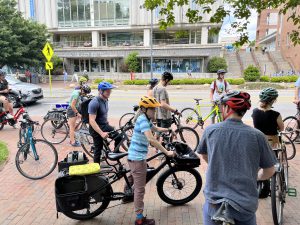
Flipping the Script bike ride
- On April 28, 2022, Offer Grembek, UCB, presented on the principles of the Safe System approach to the California Department of Motor Vehicles.
- On April 22 and 23, 2022, DCRP, led by Tab Combs, hosted the Flipping the Script on Traffic Violence workshop. The event featured a guided bike ride and walk, a facilitated discussion about marketing/storytelling by Tom Flood of Rovélo Creative, and training to develop marketing content.
Condolences for Pravin Varaiya, a pioneer in smart transportation and a UCB colleague and friend
Pravin Varaiya, a renowned expert in smart transportation systems and the Nortel Networks Distinguished Professor emeritus in the Department of Electrical Engineering and Computer Sciences at UCB, died on June 10, 2022, at the age of 81.

Pravin Varaiya
According to a tribute on the Berkeley Engineering site, Varaiya spent 50 years on the faculty of UCB’s College of Engineering, where he was known for his work on transportation systems and urban environments. His research on urban environments spoke to the significance of location as it influences gentrification, labor markets, and zoning. From 1994–97, Varaiya served as director of California PATH, a multi-university research program dedicated to the solution of California’s transportation problems. He was also a leader at the Institute of Transportation Studies, where he pioneered the concept of “vehicle platooning” to reduce inter-vehicle spacing and increase roadway utilization.
“He was undoubtedly one of the transportation systems giants of our time,” said Offer Grembek, UCB, “and on top of that, probably one of the most approachable geniuses I’ve ever met.” Learn more about Varaiya’s impressive life and career.
CSCRS Director Laura Sandt named APBP 2022 Research Professional of the Year
CSCRS Director Laura Sandt was chosen as the Association of Pedestrian and Bicycle Professionals (APBP) 2022 Research Professional of the Year. According to APBP’s announcement, “Laura encourages the uptake of research to practice by leading opportunities for knowledge exchange, as well as interfacing directly with leaders in multidisciplinary fields and informing adoption and implementation of ideas.”
In a recorded message shared with awards ceremony attendees in August 2022, Sandt said, “It means a lot to me that APBP has an award that celebrates research, because I believe that the curiosity and creative inquiry that go into research help to spark many of the advancements that we’re seeing in making walking and biking more safe, enjoyable, and inclusive.”
Other CSCRS highlights
A quick rundown of additional recent CSCRS activities:
- Jill Cooper and Aqshems Nichols, both of UCB, created the research brief “Peer Influence and Perceptions of Safety” that explores the impacts of pluralistic ignorance on traffic safety perceptions. The brief highlights research from CSCRS project R38: Assessing how private beliefs conflict with public action on Safe Systems.

Screenshot from “The Street Project”
- Eric Dumbaugh, FAU, served as an advisor on and CSCRS co-sponsored the video production of “The Street Project,” described as “an inspiring story about a massive movement across the US and around the world to reclaim our largest public spaces, our streets.”
- Offer Grembek, UCB, authored the chapter titled “Highway Crashes in California During the COVID-19 Pandemic: Insights and Considerations” as part of the new publication “Pandemic in the Metropolis: Transportation Impacts and Recovery,” released in August 2022.
- The new website Micromodes.org launched in August 2022. It is designed to improve the tracking of fatalities involving micromobility devices, starting with e-scooter fatalities. Work on the site is connected to the CSCRS project R26: Understanding micromobility safety behavior and standardizing safety metrics for transportation system integration.
- On July 27, 2022, CSCRS researcher Elyse Keefe, IPRC, and Advisory Board member Linda Bailey, District Department of Transportation, presented testimony on the crash fatality epidemic to the Congressional Caucus on Global Road Safety. The testimony was coordinated through the Association for Safe International Road Travel.
- On June 14, 2022, Grembek provided expert testimony to the California Senate Committee on Transportation on the Bicycle Omnibus Bill, which addresses different issues related to bicycle law in the state including e-bikes and bicycle lanes. Grembek focused his testimony on how the bill aligns with the Safe System approach to road safety.
- Data from the “Shifting Streets” COVID-19 Mobility Dataset,” created and maintained by Tab Combs, DCRP, was featured in Transportation Research Part D: Transport and Environment. The article, “Insights into the long-term effects of COVID-19 responses on transportation facilities,” was also co-authored by Combs.
 CSCRS bookshelf
CSCRS bookshelf
“Autonorama: The Illusory Promise of High-Tech Driving,” Peter Norton, Island Press, 2021
By Naqiy Mcmullen
Mcmullen is pursuing a Master of Urban and Regional Planning at FAU. He is a graduate research assistant focusing on road safety for vulnerable users, Vision Zero, and the Safe System approach. In his spare time he advocates for biking, transit, and walking.
Peter Norton’s perceptive and timely “Autonorama” is an essential read for professional planners, planning students, and elected officials at risk of falling for the hype of autonomous vehicles (AVs). This book provides an incisive look at how a consortium of motor industry interests have falsely sold car dependency as freedom for over a century, AVs being the latest example.
The book is meticulously researched and written, offering ample insight into the past conditions leading to the contemporary status quo of overwhelming car dependency for most of our country. Norton describes past examples of technology failing to solve the inherent spatial and safety issues of cars in cities despite utopian promises from automakers. The author is not against automated driving or anti-technology but shows how focusing on transportation policy and spending on AVs reinforces car dependency, which has proven negative effects on our wellbeing and our communities.
He ultimately advocates for a people-focused approach to planning using New Urbanism principles espoused by famous figures such as Jane Jacob, and a transportation system that prioritizes biking, walking, and transit over single-occupancy vehicles. This book is an entertaining, educational, and important read that provides a well-rounded look at the AV hype train.
CSCRS Crossroads newsletters are archived here.



